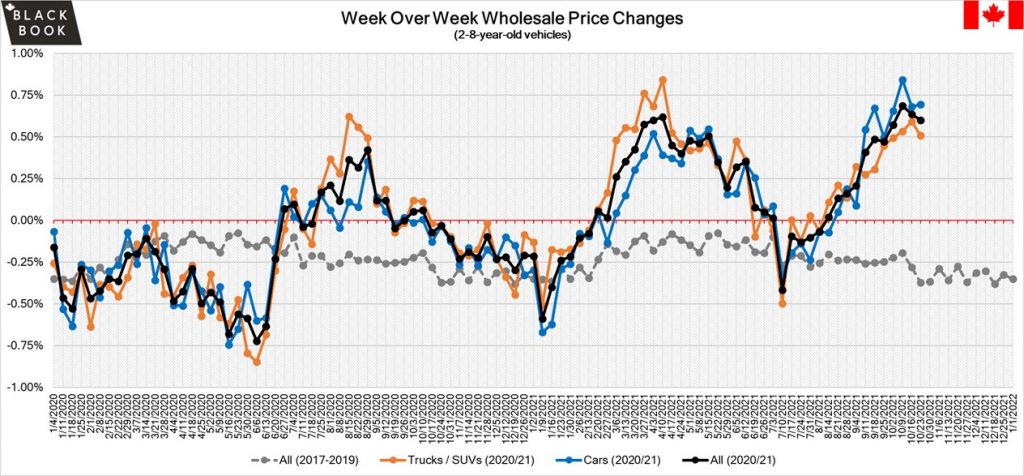Time to raise the red flag about what’s coming up, and how to manage the inevitable.
As a general principle, the non-prime market did somewhat well over the course of the pandemic, due to government aid.
The help consumers received during the COVID-19 crisis led to increased purchases for vehicles and even power sports. There was an increase in value for many reasons, and the price for used vehicles actually jumped about one per cent month-over-month—for power sports as well.
With government aid, many consumers were able to save more and spend more on things like more expensive vehicles. Some of these consumers are subprime, and specifically subprime consumers buying vehicles that are more expensive today.
The problem with this, that will inevitably present itself before us in the near future, is that consumers that buy into these more expensive vehicles will have a much higher negative equity when they want to resell or repurchase a new vehicle and trade-in that vehicle.

The problem we have today is not related to consumers getting approved at credit, because the credit approval and the default rates have been great. There is no issue with the markets as it is today.
But every lender knows that what is coming soon are rising (general) inflation rates—and higher interest rates mean consumers that are in non-prime will be the first to be impacted due to having purchased a vehicle over market value.
The whole non-prime market will see this potential issue coming fairly soon, where people will want to get out of those very expensive payments. And when they return those vehicles to a store or to try to sell them, they will be losing quite a lot, because their interest rates are higher and the vehicle price is higher. Therefore, their negative equity will be much higher.
This is a problem we are creating right now—that we created as of around last November, December, and into January. These consumers are buying high with high interest rates, and we are creating an impact that—in a few months from now, or years, or maybe a year or two—will have a lot of people buying vehicles with huge negative equities.
So for now, dealers are happy to sell vehicles during what may otherwise be a difficult period, with the vehicle inventory issue and other pandemic-related challenges. The problem is that we are shoveling negative equities, and we are not going to see such a nice scenario in a few months from now.
There is something coming—there is a wave coming, or it is already here. And what I can say is that I’m certain about that.
If you become more selective on prime, then the non-prime segment will just grow by itself.
There will be more non-prime in the coming months and years because the interest rates will be higher. Therefore, consumers will be stuck with payments and it will be complicated and challenging for dealers that are not decoding non-prime, to cater to that segment. And the reason being is that the files will get more complex.
Dealers in the market will be choosing their consumers much more wisely, because they will not be able to afford issues with clients delaying payments since their interest rate will be high. They will become more narrow in terms of the actual prime consumers they want, which will raise the non-prime segment.
That’s the effect. If you become more selective on prime, then the non-prime segment will just grow by itself. There will be more non-prime consumers in the future, and with higher negative equities.
The challenge with that is that dealers need to secure the right inventory and the right employees to deal with the more complicated files that will result from this situation.
It’s not a simple prime approval—it will require expertise. Some dealers have that expertise, but I expect artificial intelligence technology to become a key or important player in this overall situation.
These types of tools, like predictive AI, are being adopted by some dealers to help with loan-matching and customer credit management, so that more consumers are approved, and dealers don’t leave money on the table.
And this year, dealers must investigate and implement this new technology, as well as prepare their non-prime processes for the coming months. Unprepared dealers will struggle with non-prime, they will pay a high price for experienced non-prime business managers, and their sales volumes will suffer as a result.



 The year 2021 ended on a positive note for the Canadian used wholesale market which saw an increase once again, marking the 21st straight week of price increases. Declining inventory continues to drive the increase as 16 of the 22 vehicle segments saw price increases, Canadian Black Book reported in this week’s CBB Automotive Market Update.
The year 2021 ended on a positive note for the Canadian used wholesale market which saw an increase once again, marking the 21st straight week of price increases. Declining inventory continues to drive the increase as 16 of the 22 vehicle segments saw price increases, Canadian Black Book reported in this week’s CBB Automotive Market Update.










